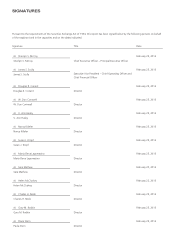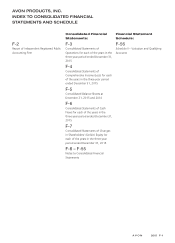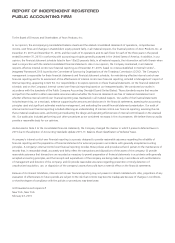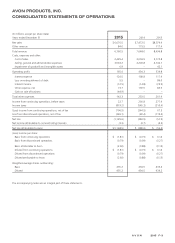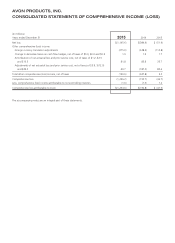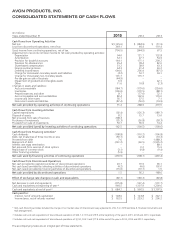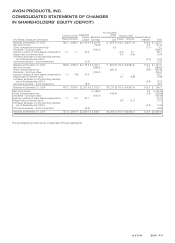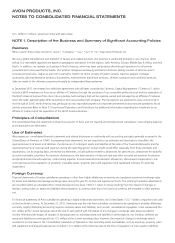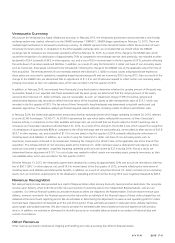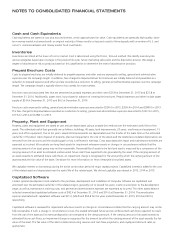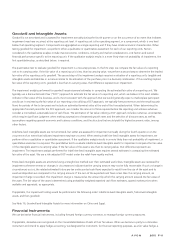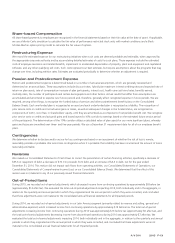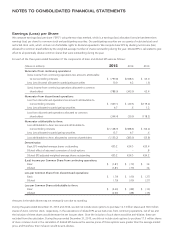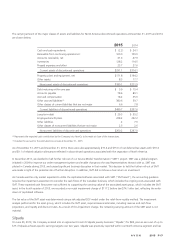Avon 2015 Annual Report Download - page 92
Download and view the complete annual report
Please find page 92 of the 2015 Avon annual report below. You can navigate through the pages in the report by either clicking on the pages listed below, or by using the keyword search tool below to find specific information within the annual report.NOTES TO CONSOLIDATED FINANCIAL STATEMENTS
Cash and Cash Equivalents
Cash equivalents are stated at cost plus accrued interest, which approximates fair value. Cash equivalents are generally high-quality, short-
term money market instruments with an original maturity of three months or less and consist of time deposits with a number of U.S. and
non-U.S. commercial banks and money market fund investments.
Inventories
Inventories are stated at the lower of cost or market. Cost is determined using the first-in, first-out method. We classify inventory into
various categories based upon its stage in the product life cycle, future marketing sales plans and the disposition process. We assign a
degree of obsolescence risk to products based on this classification to determine the level of obsolescence provision.
Prepaid Brochure Costs
Costs to prepare brochures are initially deferred to prepaid expenses and other and are expensed to selling, general and administrative
expenses over the campaign length. In addition, fees charged to Representatives for brochures are initially deferred and presented as a
reduction to prepaid expenses and other and are recorded as a reduction to selling, general and administrative expenses over the campaign
length. The campaign length is typically three to four weeks for most markets.
Brochure costs and associated fees that are presented as prepaid expenses and other were $25.8 at December 31, 2015 and $27.8 at
December 31, 2014. Additionally, paper stock is purchased in advance of creating the brochures. Prepaid expenses and other include paper
supply of $3.8 at December 31, 2015 and $6.2 at December 31, 2014.
Brochure costs expensed to selling, general and administrative expenses amounted to $256.6 in 2015, $309.4 in 2014 and $348.0 in 2013.
The fees charged to Representatives recorded as a reduction to selling, general and administrative expenses amounted to $141.9 in 2015,
$173.2 in 2014 and $188.1 in 2013.
Property, Plant and Equipment
Property, plant and equipment are stated at cost and are depreciated using a straight-line method over the estimated useful lives of the
assets. The estimated useful lives generally are as follows: buildings, 45 years; land improvements, 20 years; machinery and equipment, 15
years; and office equipment, five to ten years. Leasehold improvements are depreciated over the shorter of the lease term or the estimated
useful life of the asset. Upon disposal of property, plant and equipment, the cost of the assets and the related accumulated depreciation are
removed from the accounts and the resulting gain or loss is reflected in earnings. Costs associated with repair and maintenance activities are
expensed as incurred. We evaluate our long-lived assets for impairment whenever events or changes in circumstances indicate that the
carrying amount of an asset group may not be recoverable. Recoverability of assets to be held and used is measured by a comparison of the
carrying amount of an asset to estimated undiscounted future cash flows expected to be generated by the asset. If the carrying amount of
an asset exceeds its estimated future cash flows, an impairment charge is recognized for the amount by which the carrying amount of the
asset exceeds the fair value of the asset. See above for more information on Avon Venezuela’s long-lived assets.
We capitalize interest on borrowings during the active construction period of major capital projects. Capitalized interest is added to the cost
of the related asset and depreciated over the useful life of the related asset. We did not capitalize any interest in 2015, 2014 or 2013.
Capitalized Software
Certain systems development costs related to the purchase, development and installation of computer software are capitalized and
amortized over the estimated useful life of the related project, generally not to exceed five years. Costs incurred prior to the development
stage, as well as maintenance, training costs, and general and administrative expenses are expensed as incurred. The other assets balance
included unamortized capitalized software costs of $82.4 at December 31, 2015 and $91.6 at December 31, 2014. The amortization
expense associated with capitalized software was $31.0, $44.8 and $50.8 for the years ended December 31, 2015, 2014 and 2013,
respectively.
Capitalized software is reviewed for impairment whenever events or changes in circumstances indicate that the carrying amount may not be
fully recoverable. If such a change in circumstances occurs, the related estimated future pre-tax undiscounted cash flows expected to result
from the use of the asset and its eventual disposition are compared to the carrying amount. If the carrying amount of an asset exceeds its
estimated future cash flows, an impairment charge is recognized for the amount by which the carrying amount of the asset exceeds the fair
value of the asset. The fair value of the asset is determined using revenue and cash flow projections, and royalty and discount rates, as
appropriate.
7553_fin.pdf 82


